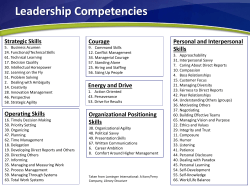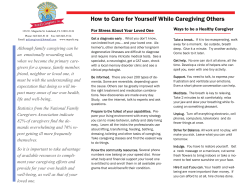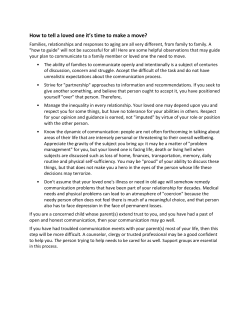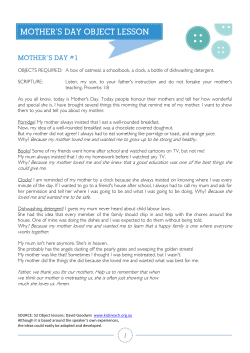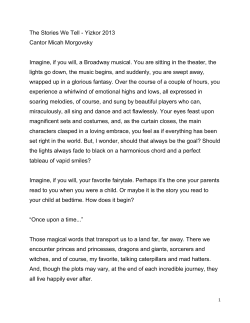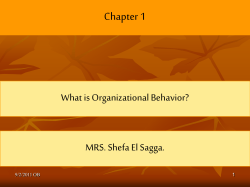
Getting Interpersonal on the Matrix
Getting Interpersonal on the Matrix: Cultivating empathy and facilitating conflict negotiation on the matrix Susan F. Balaban, Ph.D., Brattleboro Retreat Uniformed Services Program Kevin L. Polk, Ph.D., The Psychological Flexibility Group • • • Overview There is limited time and opportunity for family counseling in brief treatment contexts, but inpatients and patients in intensive outpatient programs tend to struggle painfully in their close relationships. The images below show adaptations of “the Matrix” to improve interpersonal function and relationships (i.e., context) currently being used in a partial hospital and intensive outpatient program for uniformed service professionals with a variety of behavioral health problems. The “Matrix” is employed to sort interpersonal experiences in individual, couples, family, and group modalities • • • • • Background The ACT Matrix was developed to help patients cultivate psychological flexibility and applied in numerous clinical contexts. , (Polk & Shoendorff,2014) Using the matrix entails distinguishing behavior and experiences occuring in the“outside ”5-sense world” from internal/ “mental” experiences,” as well as “away” (i.e., experiential avoidance) and “towards” ( i.e. values guided behaviors) ACT has been elaborated for self-help and family therapy modalities to improve relationship quality (e.g., Harris, 2009; Coyne et al., 2011; Dahl et al., 2013; Walser & Westrup, 2014) Interpersonal behavior can be improved by ACT (McKay et al., 2013) ACT has also been used to help families handle health problems (Brown et al., 2013, Burke et al., 2013) Group therapy: ACT For Close Relationships • • • • Purpose of Group To cultivate empathy and compassion to improve personal psychological flexibility Improve interpersonal relationships that influence well-being Focus on functioning in a valued relationship where there is conflict or guilt related to functioning poorly in relationship Clarify and articulate values, intentions, and committed actions to strengthen relationships and facilitate values guidedaction Using the Matrix for Brief and Meaningful Family Interventions: • • • • • • • • • • Parents use matrix to provide safe structure for explaining their problems, treatment, and commitments to children and adolescents • Explaining painful thoughts and feelings. • Process of Experiential Avoidance/ Away Moves • Clarifying Intentions and Valued actions/Towards Moves to provide hope and reassurance to children Patient practice mindfulness in relationship context • Therapist joins (Minuchin, 1974) with spouse/partner: o “How has this been for you?” • Patient practices mindfulness o listening and sorting thoughts, feelings and sensations on the Matrix • Patient uses diagram to • shares internal responses to partner’s statements • Validate & empathize with partner Partner learns to sorts their own experiences using the Matrix • Partner develops understanding of treatment model, so they can understand and support patient using ACT • Patient learns their partner’s perspective, e.g., how their behavior has impeded partner’s towards moves Matrix for self & loved one exercise: Interpersonal matrices pair self and loved one using “relationship values” (Harris, 2009) Identify personal values in this relationship Draw on empathy to hypothesize what loved one values in relationship Mindfully reflect on thoughts and feelings (internal/mental experiences) during painful interaction with loved one Hypothesize painful private experiences experienced by loved one Identify experiential avoidance strategies that impede engagement with values Identify loved one’s behaviors that were upsetting and use empathy to sort these under “away” or “towards” moves Generate intentions regarding personal and loved one’s values Articulate specific and separate valued actions in the service of personal and loved one’s relationship values References •Coyne, L. W., McHugh, L., & Martinez, E. R. (2011). Acceptance and commitment therapy (ACT): Advances and applications with children, adolescents, and families. Child And Adolescent Psychiatric Clinics Of North America, 20(2), 379-399. doi:10.1016/j.chc.2011.01.010 •Brown, F., Whittingham, K., McKinlay, L., Boyd, R., & Sofronoff, K. (2013). Efficacy of stepping stones Triple P plus a stress management adjunct for parents of children with an acquired brain injury: The protocol of a randomised controlled trial. Brain Impairment, 14(2), 253-269. doi:10.1017/BrImp.2013.18 •Burke, K., Muscara, F., McCarthy, M., Dimovski, A., Hearps, S., Anderson, V., & Walser, R. (2014). Adapting acceptance and commitment therapy for parents of children with life-threatening illness: Pilot study. Families, Systems, & Health, 32(1), 122-127. doi:10.1037/fsh0000012 •Dahl, J., Steward, I., Martell, C., & Kaplan, J. S. (2013). ACT and RFT in relationships: Helping clients deepen intimacy and maintain healthy commitments using acceptance and commitment therapy and relational frame theory. Oakland, CA, US: Context Press/New Harbinger Publications. •Harris, R. (2009) ACT with Love: Stop Struggling, Reconcile Differences, and Strengthen Your Relationship with Acceptance and Commitment Therapy, Oakland, CA, US: New Harbinger Publications •McKay, M., Lev, A., & Skeen, M. (2012). Acceptance and commitment therapy for interpersonal problems: Using mindfulness, acceptance, and schema awareness to change interpersonal behaviors. Oakland, CA, US: New Harbinger Publications. •Minuchin, S. (1974). Families and Family Therapy. Harvard University Press. •Polk, K.L. & Schoendorff, B. (2014). The ACT Matrix: A New Approach to Building Psychological Flexibility Across Settings and Populations. Oakland, CA, US: Context ress •Walser, R., & Westrup D. (2014) The Mindful Couple: How Acceptance and Mindfulness Can Lead You to the Love You Want. Oakland, CA, US: New Harbinger Publications.
© Copyright 2025

